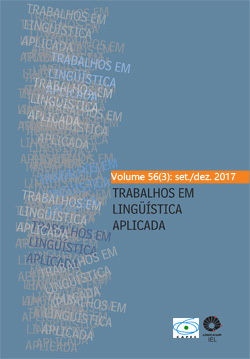Resumen
This study deals with personal experiences of a young female Brazilian immigrant learning English as a second language in London. Data were generated through narrative inquiry procedures, aimed at registering personal stories of the participant’s recollection of events. The results showed that learning English as a second language was a painful experience, especially at school, where the participant felt different for being an immigrant and not speaking the language which created a barrier to interact with other students. Also according to her, it appeared to be a reason to be bullied by her classmates. Despite such struggle, she was able to learn, acknowledging the support from her parents and daily interactions with people, rather than learning experiences in formal schooling.
Citas
BELL, J. (2002). Narrative inquiry: More than just telling stories. TESOL Quarterly, v.36, nº 2, pp. 207–213.
CLANDININ, D.J., & CONNELY, F.M. (1996). Teachers’ Professional Knowledge Landscapes: Teacher Stories – Stories of Teachers – School Stories – Stories of Schools. Educational Researcher, v. 25, nº 3, pp.24-30.
CLANDININ, D.J. (2006). Narrative Inquiry: a methodology for studying lived experience. Research Studies in Music Education, v.27, nº 1, pp.44-54.
CLANDININ, D.J. (2015). Stories to live by on the professional landscape. Waikato Journal of Education, v.1, nº 3, pp.183-193.
CONNELY, F.M.; CLANDININ, D.J. (1990). Stories of Experience and Narrative Inquiry. Educational Researchers, v.25, nº 3, pp.24-30.
CONNELY, F.M., & CLANDININ, D.J. (2006). Narrative Inquiry. In: Green, J.L.; Camilli, G.; Elmore, P. (Eds.), Handbook of complimentary methods in education research. Mahwah, NJ: Lawrence Erlbaum, pp.477-487.
GU, M., & PATKIN, J. (2013). Heritage and identity: Ethnic minority students from South Asia in Hong Kong. Linguistics and Education, v.4, nº 2, 131-141.
HAREL-FISH, Y., WALSH, S., FOGEL-GRINVALD, H., AMITAI, G., PICKETT, W., MOLCHO, M., DUE, P., MATOS, M.G., CRAIG, W. (2011). Negative school perceptions and involvement in school bullying: a universal relationship across 40 countries. Journal of Adolescence, v. 34, nº 4, pp.639-652.
HALL, G. (2011). Exploring English Language Teaching: Language in Action. New York, NY: Routledge.
HONG, J.S., & ESPELAGE, D.L. (2012). A review of research on bullying and peer victimization in school: An ecological system analysis. Aggression and Violent Behavior, v.17, nº 4, pp.311-322.
KUMARAVADIVELU, B. (2012). Language Teacher Education for a Global Society: a modular model for knowing, analyzing, recognizing, doing and seeing. New York, NY: Routledge.
OLWEUS, D. (1993).Bullying at school: What we know and what we can do. Oxford & Cambridge, UK: Blackwell Publishers.
RAYNOR, S., & WYLIE, A. (2012). Presentation and management of school bullying and the impact of anti-bullying strategies for pupils: a self-report survey in London schools. Public Health, v.126, nº 9, pp.782-789.
SHACKLOCK, G., & THORP, L. (2005). Life history and narrative approaches. In: Somekh, B.; Lewin, C. (Eds.). Research Methods in the Social Sciences, London, UK: Sage, pp.156-163.
SHIN, J.Y., D’ANTONIO, E., SON, H., KIM, S., PARK, Y. (2011). Bullying and discrimination experiences among Korean-American adolescents. Journal of Adolescence, v.34, nº 5, pp.873-883.
TIPPET, N., WOLKE, D., PLATT. (2013). Ethnicity and bullying in a national UK youth sample. Journal of Adolescence, v.36, nº 4, pp.639-649.
TOLSMA, J., VAN DEURZEN, I., STARK, T.H., VEENSTRA, R. (2013). Who is bullying whom in ethnically diverse primary schools? Exploring links between bullying, ethnicity, and ethnic diversity in Dutch primary schools. Social Networks, v.35, nº 1, pp.51-61.
USITA, P.M. (2005). Social geography and continuity effects in immigrant women’s narratives of negative interactions. Journal of Aging Studies, v.19, nº 2, pp.221-239.
VANDEYAR, S. (2012). Immigrant students’ shifting identifications in South African schools. International Journal of Educational Development, v.32, nº 2, pp.232-240.
VYGOTSKY, L.S.; LURIA, A. (1993). Ape, Primitive Man, and Child: Essays in the History of Behaviour. New Jersey: Lawrence Erlbaum Associates.
WEBSTER, L., & MERTOVA, P. (2007). Using Narrative Inquiry as a Research Method: an introduction to using critical event narrative analysis in research on learning and teaching. New York, NY: Routledge.

Esta obra está bajo una licencia internacional Creative Commons Atribución 4.0.
Derechos de autor 2019 Trabalhos em Linguística Aplicada

